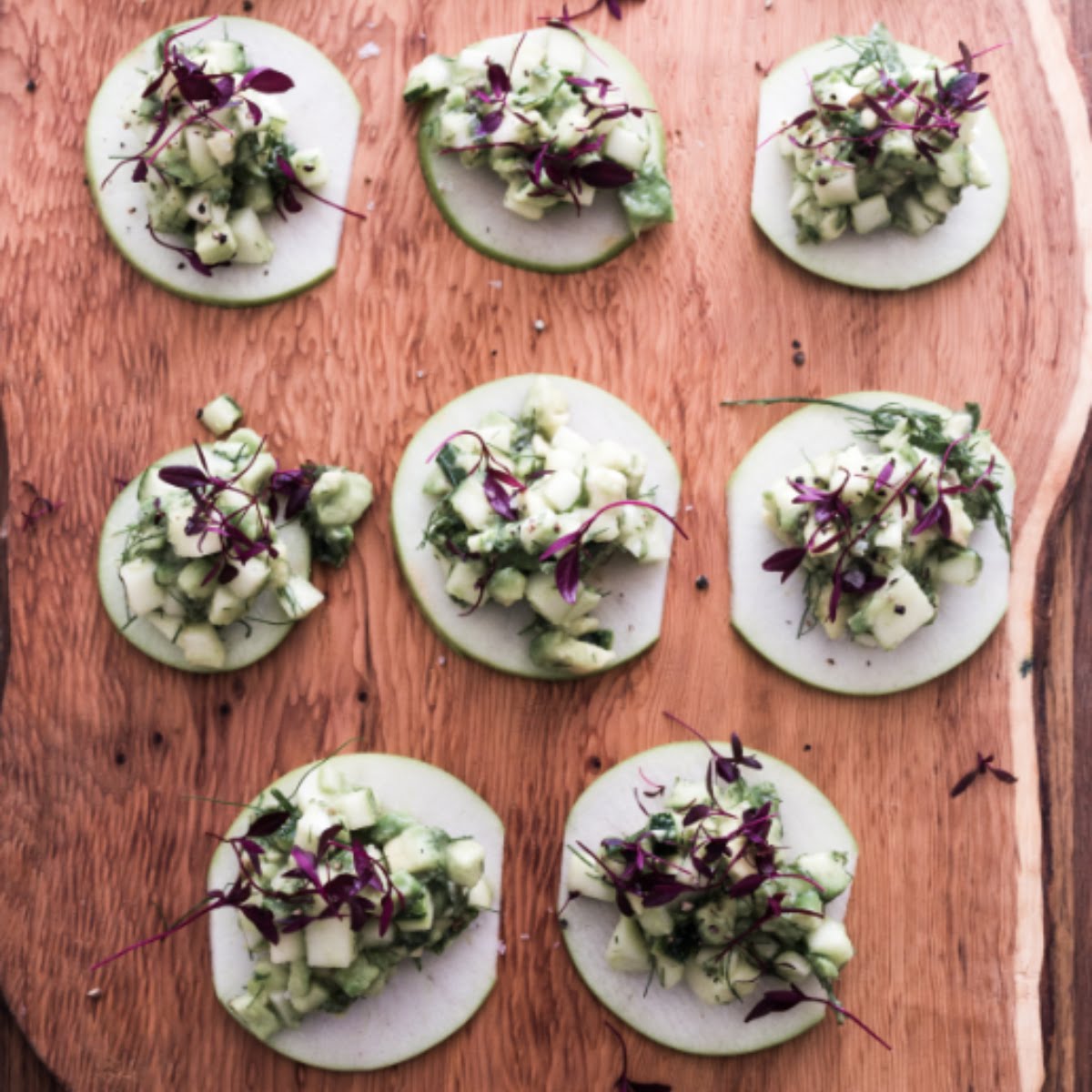
Five delicious vegetarian recipes to enjoy over the Christmas season
Whether you're going all-out vegetarian this year, or just want to spice up your side dish offering, these delicious meat-free Christmas recipes from Katie Sanderson will certainly get your tummy rumbling.
Celebrate the season with a twist, as chef and vegetarian Katie Sanderson shares her Christmas recipes. Whether you want to go full veggie or upgrade your sides, there’s inspiration aplenty…
To start: Courgette, apple and avocado bites
Serves 6
At this time of year, food can be heavy so I like to kick off a meal with these zesty bites to wake up the palate.
The trick to this simple canapé is to get an equal amount of avocado, courgette and apple and cut them into evenly-sized small chunks. Each of these ingredients tends to discolour quite quickly, so it’s best to prep this dish just before you intend to serve it. You can chop the courgette and the apple in advance and leave them to sit in the freshly squeezed lemon juice, but don’t add the avocado into the mix until you’re ready to serve, as the lemon juice will turn the avocado brown.
Ingredients
- 3 avocados, peeled, stoned and diced
- 2 courgettes, peeled and diced
- 1 green apple, core removed and diced
- 1/2 cup of freshly squeezed lemon juice
- sea salt and pepper
- 2 tbsp chopped fresh mint or dill, or any zesty fresh herb you like
- sprouts (pink or red if possible), to garnish
- 2 green apples, sliced thinly with a mandoline
Method
- Once the avocado, courgette and apple are chopped, mix everything together, season with salt and pepper and sprinkle with the fresh herbs.
- If you haven’t already added the lemon juice, do so now. Taste and adjust seasoning as needed.
- Place a spoon of the mix on each thin – slice of apple, top with sprouts and a touch more seasoning and hand them around.
For soup: Miso seaweed broth with roasted carrots, red onion, and greens
Serves 4
I love cooking with seaweed and making broths is one of my favourite ways to enjoy the taste. Daishi is a seaweed stock and the backbone of all Japanese cuisine. Typically kombu or kelp is used to make this stock, but recently I’ve been using a lot of wakame to make stock with great results.
Ingredients
- 5-8 carrots, cleaned and halved
- 3 red onions, skin on, quartered
- glug of olive oil
- 800ml water
- dried kombu (1 sheet), or 2 pieces of wakame or dillisk
- 2 tbsp miso paste, you can use light or dark or a mix of both is great
- 2 tbsp tamari or soya
- a handful of cabbage, kale or spinach
- fresh parsley, to garnish
Method
- Preheat the oven to 180ºC. Add a glug of olive oil to a roasting tray and roast the red onions and carrots until coloured and soft (about 30 mins).
- Place a pot over a low heat, add the water and the seaweed and heat gently to extract the flavour of the seaweed. Once the water is hot but not boiling, remove from the heat and give the seaweed a chop, leaving it in the liquid. If using a bigger piece of seaweed such as kelp or kombu, take it out, slice it extra thin and add it back in. Add your miso paste and tamari/soya and whisk together. Place back on a low heat for another 5 mins. Taste and if it needs a bit more flavour add a touch more soya or tamari.
- Warm large soup bowls, add the roast carrots, red onion and whatever greens you choose to use. Pour the hot broth over the top, stir around to wilt the greens slightly and then top with parsley.
For mains: Black potatoes
Serves 6
This recipe is my take on a Bar Tartine recipe, where they roast, smoke and fry potatoes, then finish them off with black garlic. Black garlic is dehydrated garlic cooked in a rice cooker for two weeks; the taste is sublime. My version, though still cooked slowly, is done in one day. I’m serving these with homemade aioli, but lemon yoghurt or crème fraîche would be great either.
Ingredients
- glug of olive oil
- 300g garlic cloves, peeled
- 200ml balsamic vinegar
- 50g fresh thyme, leaves pulled from stalk
- 2 tbsp honey
- 1.5kg potatoes, skin on or off, chopped
- sea salt and pepper
- fresh rosemary and thyme, for roasting
- spring onion and picked parsley, to garnish
Method
- Preheat the oven to 200•C and place a roasting tray inside to heat up.
- In a heavy-bottomed pan, add oil and garlic and cook on the lowest possible heat. This is the only time that I prefer electric to gas hobs. (If you have a gas hob, chances are the heat is too high. If so, place the pot on top of another pan so that the heat is diffused.) The aim is for the garlic to cook really, really slowly (30-50 mins). If the garlic is starting to colour or the oil is bubbling the heat is far too high. When you can easily crush the garlic with a fork and as it’s starting to go golden, add the balsamic vinegar, honey and thyme and reduce the liquid. I squish some of the garlic to make a paste but like to leave some bigger bits too. Once it has thickened and become paste-like, set aside.
- Put your chopped spuds into a pot of boiling water and place over a medium heat to parboil. Once cooked a little, but still retaining a bite, drain as thoroughly as possible. A few bangs of the colander against the side of your sink should do the trick.
- Add some olive oil to your heated roasting tray and then return it to the oven for another five minutes. Remove the tray and distribute the potatoes in an even layer with lots of space in between (this space and airflow will result in a crispier end product), if they make a sizzling noise when they hit the oil this is a good sign. Season with salt and pepper and roast in the hot oven for about 40 mins, until crispy.
- When ready to serve, gently heat the garlic paste and smother over the crispy potatoes. Sprinkle with parsley and spring onion, before adding a final seasoning of salt and pepper to serve.
For mains: Burnt kale, crispy garlic peanut butter, and chilli
Serves 6
I really feel that kale likes to be burnt slightly, the flavour when some of it is charred or blackened is fantastic.
Ingredients
For the chilli ginger vinegar
- 160g fresh red chilli, trimmed and chopped or whizzed €40g fresh ginger, peeled and grated or whizzed roughly
- 100ml vinegar
- 1 tbsp honey
For the kale
- olive oil
- 300g kale, tough stalks removed, chopped roughly
For the garlic peanut butter
- 300ml sunflower oil
- 3 garlic cloves, peeled
- 150g peanut butter
Method
- Add the chopped chillies to a pan over a low heat.
- Add the ginger, honey and vinegar and cook for about 8 mins until slightly soft.
- Allow to cool and then transfer to a sterilised jar. This vinegar will keep in the fridge for two months or more.
- Place a frying pan over a high heat until it’s smoking and then add a dash of oil and let it heat further.
- Cook the kale in batches, being careful not to overload the pan as this will slow down the cooking. To get that burnt effect, you want to avoid the temptation to stir with a wooden spoon. Let the kale sit for a minute and blacken where it hits the pan; once it’s coloured give it a little stir and then take off the heat. One side should be soft and the other slightly burnt. You can cook the kale ahead of time and place back in the pan to heat through or serve at room temperature.
- For the garlic peanut butter, add the oil to a pot and heat until it is hot enough that when you throw a clove of garlic in it sizzles. Have a sieve balanced over a stainless steel pot or bowl ready as the garlic will fry very quickly in the hot oil.
- Add the garlic to the oil and watch it. When it’s slightly coloured, pour the contents of the pot through a sieve so the oil is in a bowl and the crispy garlic is resting in the sieve. You want to be careful not to overcook the garlic or the oil will taste bitter.
- Add three tablespoons of the infused garlic oil to the peanut butter to thin it out, then spoon the peanut butter over the charred kale and top with the chilli ginger vinegar and some salt and pepper.
For nibbles: Raw cacao truffles
Serves 6-8
I’m interested in how food makes us feel, and the resulting energy, or lack of, it can give us. By working without dairy and processed sugars from time to time, I feel it brings more balance to the food we are consuming. These truffles are heavenly and no one would know that they are free of dairy, gluten and refined sugar.
Ingredients
For the truffles
- 75g cacao butter
- 280g cashew butter
- 280ml maple syrup or honey
- 1 tsp vanilla extract
- 20ml water
- 40g cacao powder
For the coating
- Anything you like! We used crushed pistachio nuts, desiccated coconut, and Korean red chilli flakes.
Method
- Melt the cacao butter in a bain-marie or in a pot over a very, very low heat, being careful not to burn or overheat the liquid.
- In a high-speed blender, mix the cashew butter, honey or maple syrup, vanilla and water to form a smooth paste, add the cacao powder and finally the melted cacao butter. Add them in, in a slow, steady stream to emulsify.
- Place the mixture in the fridge for an hour or so to harden and then roll into balls.
- Coat your truffles in whatever takes your fancy, you can add nuts through the mix too if you like. I like to add a little sea salt or Korean chilli but do experiment and make them your own.
Photography Nathalie Marquez Courtney Tableware Article Flowers The Garden at Powerscourt Townhouse
This article was originally published in December 2023.





























